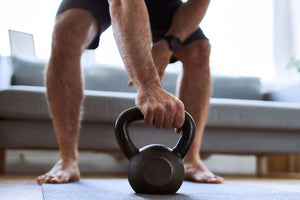Male, female, young, or old. We all want a tight and toned midsection.
Try as we might, few of us ever attain (and more importantly, maintain) a lean, defined core. This isn’t for lack of trying in the gym…millions (if not billions) of crunches and planks are done each year, but there’s still a layer of “goo” cemented around our collective cores.
Nutrition is imperative, make no mistake about that. In fact, it is the key factor in stripping away fat, but to make your abs really “pop”, training is essential.
Unfortunately, decades of incorrect information have resulted in poor ab training programs, leaving many of us lacking muscle definition and reeling with aching low backs and necks.
If you’re tired of not seeing the results you want from your efforts in the gym (and the kitchen), then pay attention!
We’re going to give you FIVE key reasons why your ab workouts don’t work.
#1 Spot Training
In an ideal world, we could remove unwanted body fat from the most unsavory locations on our body (belly, hips, thighs, etc.) and increase lean muscle where we want.
Unfortunately, human physiology doesn’t naturally work that way. In other words, you can’t “target belly fat” or spot reduce. It’s a myth, pure and simple.
Training a muscle group directly does increase blood flow and lipolysis (the breakdown of stored fatty acids into usable energy) in the area you are training, but the effect is pretty negligible.
In other words, resistance-training can help your muscle to grow bigger (as well as burn calories), but it doesn’t directly burn body fat in that specific region.
Anyone telling you otherwise is trying to pull a fast one (i.e. outright mislead and/or lie to you).
So, keep training your abs to make them stronger, but it’s not going to get rid of the layer of fat covering them.
Speaking of training your abs, let’s discuss the right way to train your abs (hint: it’s not doing crunches or sit-ups).
#2 Performing the Wrong Ab Exercises
Generic ab training advice is to perform dozens (if not hundreds) of reps of crutches and sit ups along with a healthy helping of planks. While you may think you’re getting a great workout performing hundreds of reps of various exercises, the truth is that you’re mostly wasting energy and setting yourself up for a potential sore neck and low back.
The best ab exercises are the ones that provide high amounts of tension across the abs/core, and sit ups aren’t doing that.
Exercises such as hanging leg raises, captain’s chair, cable crunches, and ab wheel rollouts are the best bang for your buck exercises you can do for directly training your abs.
#3 Ignoring Heavy Compound Exercises
Direct ab training has its place in developing a toned, sleek midsection, but don’t discount the value that heavy compound exercises like the squat, deadlift, bent over row, pullup, and farmer’s walks have to offer.
While the abs may not be the focus during compound movements, they are absolutely involved (there’s really no choice if you’re pushing yourself). In fact, one study found that performing back squats activates abs and external oblique muscles as effectively as the weighted plank and the spinal erectors significantly more![1]
The bottom line is that the best way to train your abs, is to focus first on heavy, compound exercises, and supplement with a handful of the best ab exercises (see #2 above).
#4 Not Utilizing Progressive Overload
One HUGE mistake individuals make when training abs is that they keep performing the same exercises for the same number of reps. You wouldn’t expect to see results in your chest, back, quads, etc. if you weren’t constantly challenging your muscles and pushing for either more weight or more reps, so why should the abs be any different?!
The challenge is in figuring out ways to create overload. Fortunately, there are plenty of ways that you can make ab exercises more challenging -- adding weight is just one way.
To make ab exercises more challenging, you can also:
- Perform more reps
- Perform harder variations (e.g. hanging leg raises vs hanging knee raises)
- Slow down the tempo (e.g. use a 3-second)
- Increase range of motion
- Use pre-fatigue and/or superset exercises
#5 Your Form is Terrible
As with other exercises, ab exercises need to be performed properly in order to get the muscle and strength benefits.
Far too many people go for speed/rep chasing when performing ab exercises, but if you really want to maximize tension and challenge your core/abs, then you must perform each and every rep under control.
That means no bouncing, no using momentum, no letting gravity do the work, etc.
Slowly extend under control and powerfully contract your muscles to return to the starting position (just like you do with every other exercise for every other muscle in your body).
The Bottom Line
Having tight, toned abs is a goal for many of us. Few, if any, actually achieve it.
To build a strong core, you have to perform compound exercises and supplement with the right ab exercises, performed with good form.
To have a lean, toned stomach, you must eat right. For many of us, that means eating a reduced calorie diet to strip away unwanted body fat.
We’ve created the 1UP Fitness App to help you dial in your nutrition plan, understand the right amount of calories to eat to lose weight, and build an exercise plan that is effective and sustainable so that you can get the results you want and live the fit, healthy life we’re all meant to live!
References
- van den Tillaar R, Saeterbakken AH. Comparison of Core Muscle Activation between a Prone Bridge and 6-RM Back Squats. J Hum Kinet. 2018 Jun 13;62:43-53. doi: 10.1515/hukin-2017-0176. PMID: 29922376; PMCID: PMC6006542.






